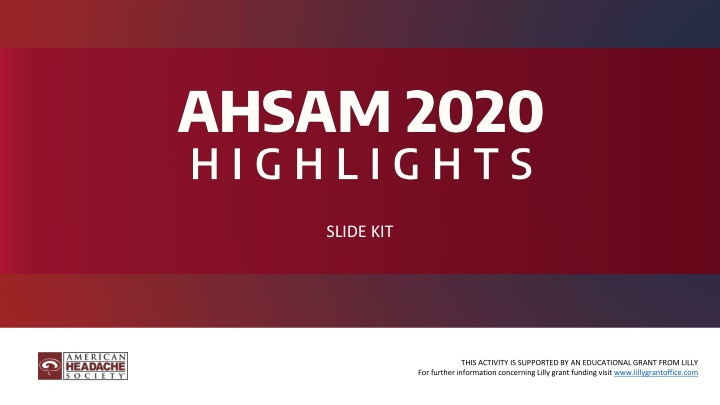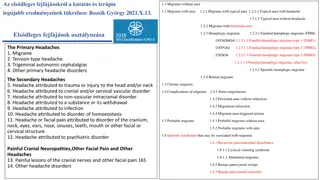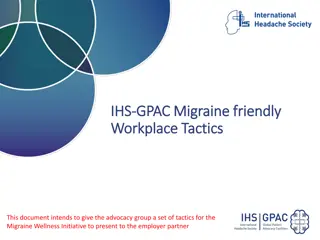The Role of Cerebellar CGRP in Migraine
Calcitonin gene-related peptide (CGRP) plays a critical role in migraine pathophysiology. This presentation explores the role of CGRP in the cerebellum and its potential contribution to migraine-like behaviors. The study investigates CGRP expression in mice and its effects on behavior through various assays, shedding light on the understanding of migraine mechanisms.
Download Presentation

Please find below an Image/Link to download the presentation.
The content on the website is provided AS IS for your information and personal use only. It may not be sold, licensed, or shared on other websites without obtaining consent from the author.If you encounter any issues during the download, it is possible that the publisher has removed the file from their server.
You are allowed to download the files provided on this website for personal or commercial use, subject to the condition that they are used lawfully. All files are the property of their respective owners.
The content on the website is provided AS IS for your information and personal use only. It may not be sold, licensed, or shared on other websites without obtaining consent from the author.
E N D
Presentation Transcript
SLIDE KIT THIS ACTIVITY IS SUPPORTED BY AN EDUCATIONAL GRANT FROM LILLY For further information concerning Lilly grant funding visit www.lillygrantoffice.com www.lillygrantoffice.com
SLIDE KIT The Role of Cerebellar CGRP in Migraine The Role of Cerebellar CGRP in Migraine- -like like Behavior Behavior. . Presented by Mengya MengyaWang Wang, Master Graduate student and research assistant Graduate student and research assistant Department of Neuroscience and Pharmacology, University of Iowa Department of Neuroscience and Pharmacology, University of Iowa Iowa City, Iowa Iowa City, Iowa Developed by Infomedica Medical Education& Information AHS Virtual Annual Scientific Meeting content is made available to an international audience through a licensing agreement between Infomedica and the American Headache Society. Infomedica is an independent medical education provider that delivers medical information to healthcare professionals through conference coverage and online educational programs and activities.
A M E R I C A N H E A D A C H E S O C I E T Y V I R T U A L A N N U A L S C I E N T I F I C M E E T I N G O F F I C I A L H I G H L I G H T S Key messages Calcitonin gene-related peptide (CGRP) plays a critical role in migraine pathophysiology, but the location and mechanisms of CGRP in migraine are still unknown. Cerebellar CGRP, especially in the fastigial nucleus, may contribute to some migraine-like phenotypes. DEVELOPED BY
A M E R I C A N H E A D A C H E S O C I E T Y V I R T U A L A N N U A L S C I E N T I F I C M E E T I N G O F F I C I A L H I G H L I G H T S Background What do we already know about this topic? Previous studies suggest calcitonin gene-related peptide (CGRP) plays a critical role in migraine pathophysiology, but the location and mechanisms of CGRP in migraine are still unknown. A high number of CGRP binding sites are located in the cerebellum, which serves as a sensory and motor integrative center, and is activated during a migraine attack.1 CGRP is densely distributed in the Purkinje cells (PCs) and cerebellum medial nucleus, suggesting that CGRP may act on the cerebellum to induce migraine-like behaviors. DEVELOPED BY
A M E R I C A N H E A D A C H E S O C I E T Y V I R T U A L A N N U A L S C I E N T I F I C M E E T I N G O F F I C I A L H I G H L I G H T S Background How was this study conducted? (1) CGRP expression was measured in the cerebellum of C57BL/6 mice using qPCR and immunohistochemistry, and in calca-cre mice using a cre-dependent viral reporter (AAV-EF1a-DIO-EYFP). The mice were injected with CGRP into the cerebellar vermis V and fastigial nucleus and tested in the light-dark assay to evaluate light aversion. An open field test was used to evaluate anxiety and locomotion, sensitivity to plantar Von Frey filaments, and a squint test was used to evaluate pain. DEVELOPED BY
A M E R I C A N H E A D A C H E S O C I E T Y V I R T U A L A N N U A L S C I E N T I F I C M E E T I N G O F F I C I A L H I G H L I G H T S Background How was this study conducted? (2) A cerebellar CGRP sensitized mouse model (L7/hRAMP1) was created to further test the role of cerebellar CGRP in migraine. Rats were injected with CGRP into crus I in the cerebellar cortex and were run in an interval estimation task. DEVELOPED BY
A M E R I C A N H E A D A C H E S O C I E T Y V I R T U A L A N N U A L S C I E N T I F I C M E E T I N G O F F I C I A L H I G H L I G H T S Findings What does this study add? (1) RNAs for both CGRP and its receptor subunits were detected in the cerebellum of C57BL/6 mice. CGRP immunoreactivity was detected in PCs and deep cerebellar nuclei. EYFP was present in fastigial nucleus neurons after injection of AAV-EF1a-DIO- EYFP into calca-cre mice but wasn t detected in PCs, which suggests that PCs accumulate, but do not produce CGRP. Injection of CGRP to the fastigial nucleus induced light aversion, anxiety, and allodynia, while delivery to the vermis V induced anxiety and a trend towards light aversion. DEVELOPED BY
A M E R I C A N H E A D A C H E S O C I E T Y V I R T U A L A N N U A L S C I E N T I F I C M E E T I N G O F F I C I A L H I G H L I G H T S Findings What does this study add? (2) Phenotypes began to present from different time points following injection of CGRP into vermis V and fastigial nucleus, suggesting that light aversion, as well as anxiety, was present. Preliminary data showed that CGRP injection to the fastigial nucleus of L7/hRAMP1 mice and control littermates induced comparable light aversion and anxiety, suggesting that RAMP1 in PCs is not rate-limiting for those CGRP actions. CGRP injection into crus I showed a trend to impair timing. DEVELOPED BY
A M E R I C A N H E A D A C H E S O C I E T Y V I R T U A L A N N U A L S C I E N T I F I C M E E T I N G O F F I C I A L H I G H L I G H T S Perspectives How does this study impact clinical practice? Cerebellar CGRP, especially in the fastigial nucleus, may contribute to some migraine-like behaviors such as light aversion, anxiety, and decreased locomotion. While further studies are needed to determine the contributions of cerebellar CGRP to light aversion, there are connections between the fastigial nucleus and the posterior thalamic area, which are implicated in photophobia. DEVELOPED BY
A M E R I C A N H E A D A C H E S O C I E T Y V I R T U A L A N N U A L S C I E N T I F I C M E E T I N G O F F I C I A L H I G H L I G H T S References 1. Moulton EA, Schmahmann JD, Becerra L, Borsook D. The cerebellum and pain: passive integrator or active participator?. Brain Res Rev. 2010;65(1):14-27. DEVELOPED BY






















